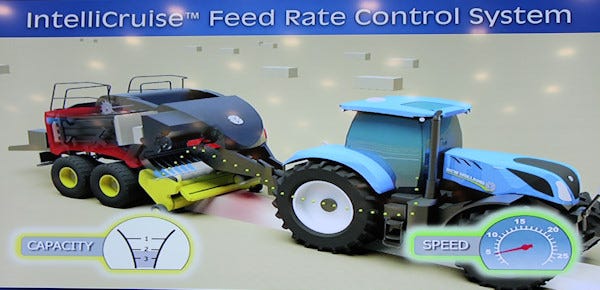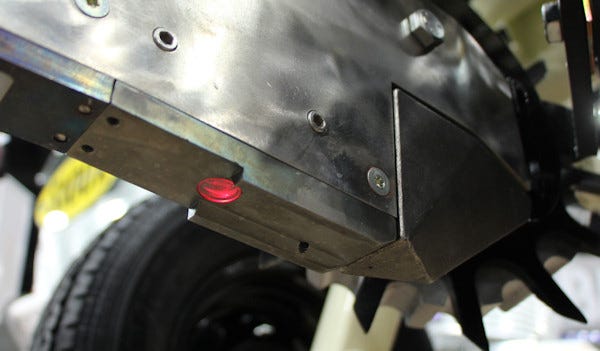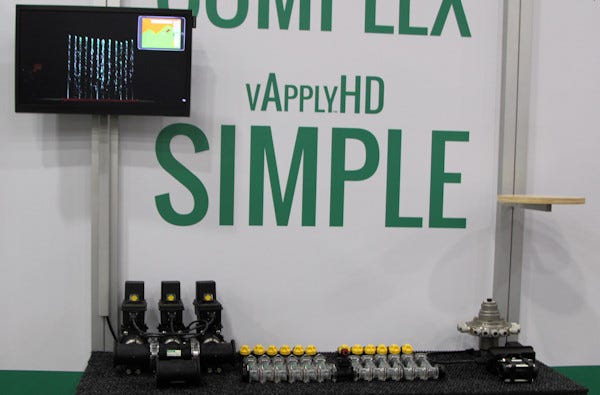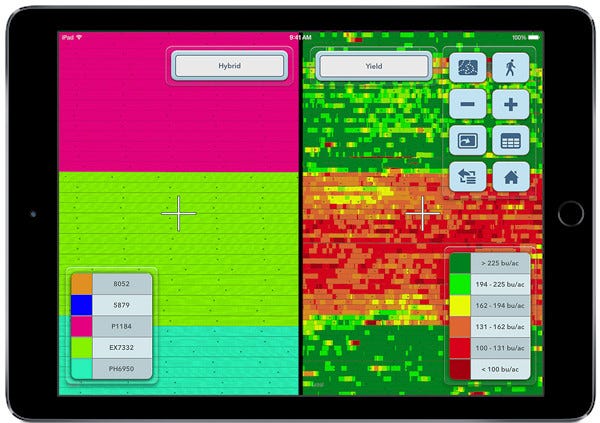March 25, 2016

Even though the market for farm machinery is still down this year, manufacturers aren’t putting a cap on innovation. It’s a message that most anyone who attended the 2016 National Farm Machinery Show would have to walk away with.
This indoor farm show, one of the largest in the country, draws around 800 exhibitors, many of whom had something new to show. Farm Industry News captured the hottest and newest of those in our 2016 farm show coverage, which you can read about in our series of galleries from the event. Check out Soil sampling, livestock tools and grain handling; Skid steer steel wheels, new tracks, grain drying tech; and Tillage, tractors and tools.
In making our rounds over the 1.2 million square feet of floor space, we observed some clear technology trends that are arguably shaking up the farm machinery industry. Here’s what we see are seven game-changers.
1. Aerial imaging remains one of the most talked-about technologies. Field images taken from the sky, whether using drones, planes, or satellites, are a big business and a big market in farming. More companies are getting into the game to meet a growing demand among farmers. Providers reported that farmers are using the images to identify where in the field to scout for problems that could hurt crop yield. Those images can reveal crop stress before the naked eye can see the problem.
2. Smart phones are bringing the IoT to the farm. JCA Electronics, an electronics integration company, says the biggest change in its industry in recent years has been the advent of smart devices. They give you the computing power of a laptop in a device that is mobile, georeferenced and equipped with a modem, making it capable of wireless communication and a hub for machine-to-machine communication. John Anderson, the president of the company, says the technology do those things has been around for a while, but smart devices are making it affordable because they come with their own display and apps for navigation and control.
3. Farm implements are starting to outsmart tractors. Isobus, the international standard that has enabled tractors and implements of different colors to communicate, is headed into its next phase called Isobus III, whereby an implement can tell the tractor that pulls it what to do. The highest-tech balers, for instance, are able to tell a tractor when to speed up or slow down based on the amount of crop that is being fed into it, which keeps the baler and the tractor operating at optimal efficiency. The technology is called Tractor-Implement Management, or TIM, and New Holland showed an example of it, which it calls IntelliCruise, at their booth.

New Holland calls its version of ISOBUS 3 IntelliCruise, and the baler controls the tractor for optimum efficiency.
New Holland calls its version of ISOBUS 3 IntelliCruise, and the baler controls the tractor for optimum efficiency.
4. On-the-go soil analysis is here. You used to have to pull soil samples by hand and then send them off to a lab for analysis. That process is becoming automated with the use of new tools and technologies such as the 360 SoilScan by 360 Yield Center, the Falcon 5000 automated soil sampler, and, most recently, the Veris U3, which made its debut at this year’s show. The Veris U3 uses three sensors mounted on a utility vehicle to measure, on-the-go, soil properties such as texture, pH and organic matter, the results of which can drive variable-rate seeding and nutrient prescriptions.

Veris offers the U3, a soil measurement device designed to be used with a utility vehicle. It's further evidence of the rise of using sensors to capture field information.
Veris offers the U3, a soil measurement device designed to be used with a utility vehicle. It's further evidence of the rise of using sensors to capture field information.
5. Planters are starting to see. Planters are becoming “smart” delivery systems for not just the seed but also fertilizer and pesticides. Sensors are being incorporated into each planter row unit to gauge where to place the products in relation to the seed to get the best growth. Great Plain’s new AccuShot system and Precision Planting’s vApply liquid fertilizer control system are two recent examples of that.

Precision placement of fertilizer in-season is gaining interest and tools like this from Precision Planting are improving the payback for growers.
Precision placement of fertilizer in-season is gaining interest and tools like this from Precision Planting are improving the payback for growers.
6. Corn heads are being redesigned for mass harvesting. Several companies unveiled new corn heads designed to improve grain harvesting. Making the biggest news in this arena was Gerringhoff, who publically unveiled two row-independent corn heads that can harvest any row spacing with the combine driving in any direction. The company also introduced a draper head for small grains that has an air system that blows grain into the head. Stalk choppers continue to be a much-requested add-on according to reps from Fantini and DragoTec.

This new flex draper from Geringhoff offers producers improved productivity and close cutting to maximize yield by cutting very close to the ground.
This new flex draper from Geringhoff offers producers improved productivity and close cutting to maximize yield by cutting very close to the ground.
7. Google meets the farm. After stacking up a decade or more of yield and soil maps, farms have become data warehouses, and new tech companies are stepped in to mine them. Some of the newest booths at the show were occupied by recruits from Google, who are bringing their expertise in predictive data analytics to make sense of data collected on the farm. The data is aggregated and used to build crop models that go through what-if scenarios that weigh the results of different management practices such as applying more nitrogen or irrigating a certain field. You’d be hard pressed to find a mainline OEM manufacturer who isn’t somehow aligned with one of these services, which are typically sold as annual subscriptions.

Screens are getting more useful, including this split-screen work showing how a specific hybrid might be performing in your field. The left screen shows the hybrid while the right shows yield.
Screens are getting more useful, including this split-screen work showing how a specific hybrid might be performing in your field. The left screen shows the hybrid while the right shows yield.
About the Author(s)
You May Also Like




